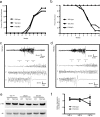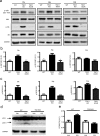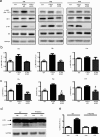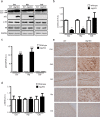Impaired autophagy in neurons after disinhibition of mammalian target of rapamycin and its contribution to epileptogenesis
- PMID: 23136410
- PMCID: PMC3501684
- DOI: 10.1523/JNEUROSCI.2392-12.2012
Impaired autophagy in neurons after disinhibition of mammalian target of rapamycin and its contribution to epileptogenesis
Abstract
Certain mutations within the mammalian target of rapamycin (mTOR) pathway, most notably those affecting the tuberous sclerosis complex (TSC), lead to aberrant activation of mTOR and result in a high incidence of epilepsy in humans and animal models. Although hyperactivation of mTOR has been strongly linked to the development of epilepsy and, conversely, inhibition of mTOR by rapamycin treatment is protective against seizures in several models, the downstream epileptic mechanisms have remained elusive. Autophagy, a catabolic process that plays a vital role in cellular homeostasis by mediating the turnover of cytoplasmic constituents, is negatively regulated by mTOR. Here we demonstrate that autophagy is suppressed in brain tissues of forebrain-specific conditional TSC1 and phosphatase and tensin homlog knock-out mice, both of which display aberrant mTOR activation and seizures. In addition, we also discovered that autophagy is suppressed in the brains of human TSC patients. Moreover, conditional deletion of Atg7, an essential regulator of autophagy, in mouse forebrain neurons is sufficient to promote development of spontaneous seizures. Thus, our study suggests that impaired autophagy contributes to epileptogenesis, which may be of interest as a potential therapeutic target for epilepsy treatment and/or prevention.
Figures







Similar articles
-
Neuronal Tsc1/2 complex controls autophagy through AMPK-dependent regulation of ULK1.Hum Mol Genet. 2014 Jul 15;23(14):3865-74. doi: 10.1093/hmg/ddu101. Epub 2014 Mar 5. Hum Mol Genet. 2014. PMID: 24599401 Free PMC article.
-
Tsc2 gene inactivation causes a more severe epilepsy phenotype than Tsc1 inactivation in a mouse model of tuberous sclerosis complex.Hum Mol Genet. 2011 Feb 1;20(3):445-54. doi: 10.1093/hmg/ddq491. Epub 2010 Nov 9. Hum Mol Genet. 2011. PMID: 21062901 Free PMC article.
-
Dysregulation of autophagy in melanocytes contributes to hypopigmented macules in tuberous sclerosis complex.J Dermatol Sci. 2018 Feb;89(2):155-164. doi: 10.1016/j.jdermsci.2017.11.002. Epub 2017 Nov 11. J Dermatol Sci. 2018. PMID: 29146131
-
Mammalian target of rapamycin (mTOR) pathways in neurological diseases.Biomed J. 2013 Mar-Apr;36(2):40-50. doi: 10.4103/2319-4170.110365. Biomed J. 2013. PMID: 23644232 Free PMC article. Review.
-
Mechanistic target of rapamycin (mTOR) in tuberous sclerosis complex-associated epilepsy.Pediatr Neurol. 2015 Mar;52(3):281-9. doi: 10.1016/j.pediatrneurol.2014.10.028. Epub 2014 Nov 20. Pediatr Neurol. 2015. PMID: 25591831 Review.
Cited by
-
Phosphorylation of AMPA-type glutamate receptors: the trigger of epileptogenesis?J Neurosci. 2013 Apr 3;33(14):5879-80. doi: 10.1523/JNEUROSCI.0496-13.2013. J Neurosci. 2013. PMID: 23554469 Free PMC article. No abstract available.
-
Does abnormal glycogen structure contribute to increased susceptibility to seizures in epilepsy?Metab Brain Dis. 2015 Feb;30(1):307-16. doi: 10.1007/s11011-014-9524-5. Epub 2014 Mar 19. Metab Brain Dis. 2015. PMID: 24643875 Free PMC article. Review.
-
Anterior thalamic nucleus stimulation protects hippocampal neurons by activating autophagy in epileptic monkeys.Aging (Albany NY). 2020 Apr 8;12(7):6324-6339. doi: 10.18632/aging.103026. Epub 2020 Apr 8. Aging (Albany NY). 2020. PMID: 32267832 Free PMC article.
-
Cleaning up epilepsy and neurodegeneration: the role of autophagy in epileptogenesis.Epilepsy Curr. 2013 Jul;13(4):177-8. doi: 10.5698/1535-7597-13.4.177. Epilepsy Curr. 2013. PMID: 24009482 Free PMC article. No abstract available.
-
PI3K isoform-selective inhibition in neuron-specific PTEN-deficient mice rescues molecular defects and reduces epilepsy-associated phenotypes.Neurobiol Dis. 2020 Oct;144:105026. doi: 10.1016/j.nbd.2020.105026. Epub 2020 Jul 24. Neurobiol Dis. 2020. PMID: 32712265 Free PMC article.
References
-
- Baybis M, Yu J, Lee A, Golden JA, Weiner H, McKhann G, 2nd, Aronica E, Crino PB. mTOR cascade activation distinguishes tubers from focal cortical dysplasia. Ann Neurol. 2004;56:478–487. - PubMed
Publication types
MeSH terms
Substances
Grants and funding
LinkOut - more resources
Full Text Sources
Medical
Molecular Biology Databases
Miscellaneous
